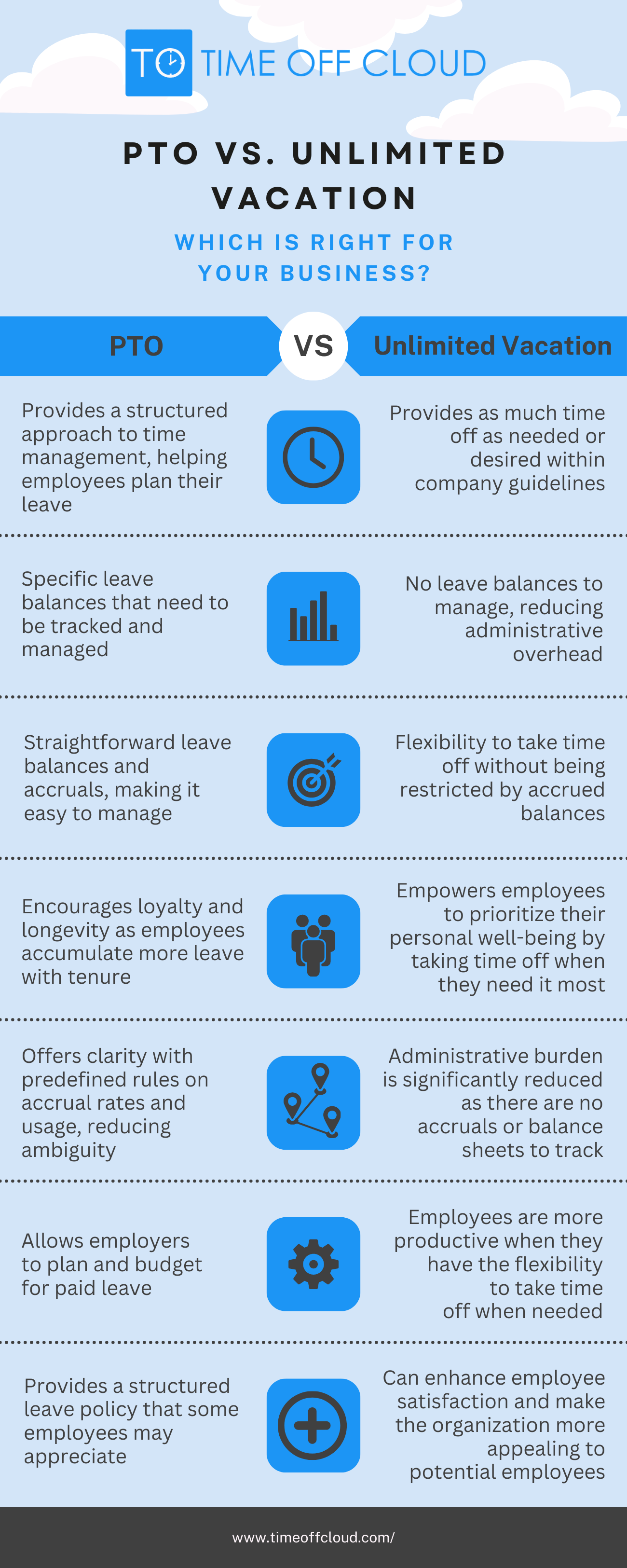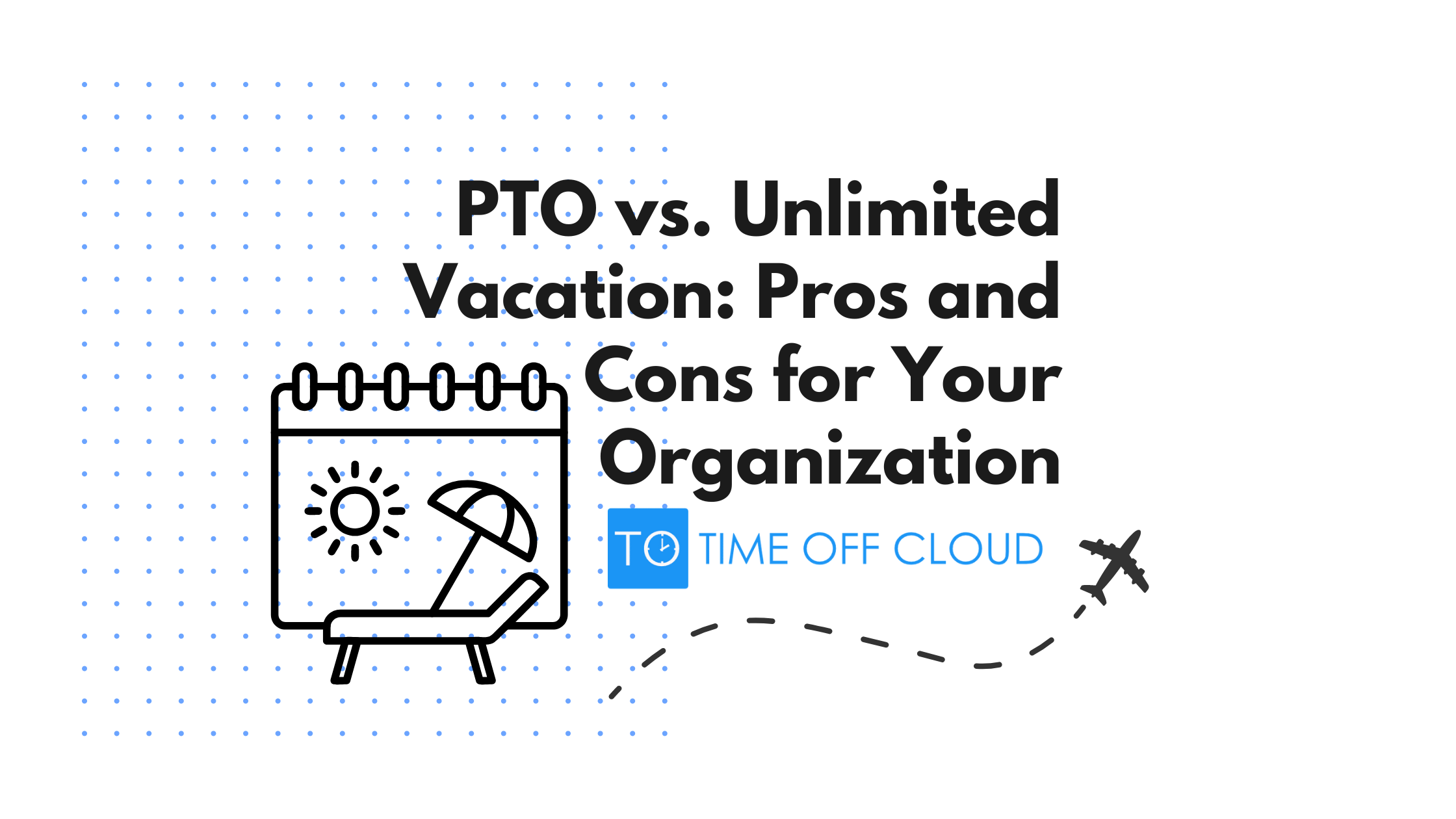Leave policies are a critical aspect of company culture and talent attraction. Two popular leave policy options that organizations often contemplate are Paid Time Off (PTO) and Unlimited Vacation. Each approach has its unique advantages and disadvantages, and choosing the right one for your organization can significantly impact your employees’ satisfaction and your company’s success overall.
Understanding Leave Policies: PTO vs. Unlimited Vacation
Before we delve into the pros and cons of each policy, let’s define and differentiate Paid Time Off (PTO) and Unlimited Vacation policies.
PTO (Paid Time Off) Policies
PTO policies are structured in a way that employees accrue a certain amount of paid leave based on their tenure, hours worked, or other predetermined criteria. This leave can be used for various purposes, including vacations, personal time, sick leave, and other absences from work. The accrual rate typically increases with an employee’s tenure, encouraging long-term commitment to the organization.
Pros of Implementing PTO Policies
- Flexible Usage: Employees can use their PTO for a variety of reasons, offering them flexibility to balance work and personal life.
- Accrual Structure: PTO policies reward loyalty and longevity, as employees accumulate more leave over time.
- Predictable Budgeting: Employers can plan and budget for paid leave, as it’s based on an accrual system with predefined rules.
Cons of PTO Policies
- Leave Balances: Managing leave balances and accruals can be complex and time-consuming for HR and payroll departments.
- Admin Overhead: HR and management must monitor and approve leave requests, which can increase administrative workload.
- Limited Employee Freedom: Employees may feel restricted by the need to accrue leave, potentially leading to burnout or reluctance to take time off.
- Scheduling Conflicts: Coordinating time-off requests among employees can lead to scheduling conflicts, especially during peak vacation seasons.
Unlimited Vacation Policies
As of 2024, about 4% of organizations offer unlimited time off. However, according to a study published by Forbes, 70% of workers are interested in these policies. policies allow employees to take as much time off as they need or desire within certain guidelines set by the company. These guidelines typically include a requirement for employees to ensure their work responsibilities are covered and that their absence doesn’t negatively impact the organization.
Pros of Implementing Unlimited Vacation Policies
- Enhanced Work-Life Balance: Employees have the freedom to manage their time off as they see fit, promoting a healthier work-life balance.
- Attracting Top Talent: Offering unlimited vacation can make your organization more appealing to prospective employees, especially in competitive job markets.
- Reduced Admin Burden: Since there’s no need to track accruals or balance sheets, the administrative burden is significantly reduced.
- Boosted Morale: Trusting employees with unlimited vacation can boost morale, as it demonstrates the organization’s faith in its workforce.
- Increased Productivity: Employees tend to be more productive when they have the flexibility to take time off when they need it, reducing burnout and absenteeism.
Cons of Unlimited Vacation Policies
- Lack of Accrual: Without accrual, there may be no financial incentive for long-term commitment to the organization.
- Ambiguity: The lack of defined limits can lead to confusion about what’s acceptable in terms of time off.
- Potential for Abuse: Some employees may exploit the system by taking excessive time off, which could harm productivity.
How to Choose Between PTO and Unlimited Vacation Policies for Your Company
Making the right choice between PTO and Unlimited Vacation policies requires a comprehensive assessment of your organization’s culture, values, operational needs, and workforce expectations. Here’s a step-by-step guide to help you make an informed decision:
Setting the Stage for the Decision-Making Process
To begin, it’s essential to set clear objectives and expectations for the decision-making process. Determine the primary goals of your leave policy, such as:
- Promoting work-life balance
- Attracting talent
- Reducing administrative overhead
- Ensuring employee well-being and satisfaction
- Enhancing organizational flexibility
- Complying with legal and regulatory requirements
Assessing Your Company’s Culture and Values
According to the U.S. Travel Association, on average, employees with unlimited vacation take only about 10 days off per year. In another study, Joblist found that 62% of respondents reported that unlimited PTO enabled them to have a healthy work-life balance. On the other hand, about 89% of workers think it’s important to have PTO.
Evaluate how each policy aligns with your company’s culture and values. For example, if your organization values flexibility and autonomy, an Unlimited Vacation policy may be more suitable. If loyalty and long-term commitment are critical, a PTO policy with accruals may align better. Consider the expectations and preferences of your workforce regarding leave policies. Conduct surveys or focus groups to gather employee feedback and integrate it into the decision-making process. Employees’ input can provide valuable insights and help ensure their needs are met.
Analyzing Operational Needs and Constraints
Assess how different leave policies may impact your organization’s operations. Consider factors such as:
- Workload fluctuations
- Impact on project timelines and deadlines
- Coverage during peak vacation seasons or critical periods
- Workforce planning and resource allocation
- The potential need for temporary staff or overtime
Ensuring business continuity and minimal disruption Evaluate the availability of administrative resources to effectively manage and track leave policies. Additionally, identify any legal or compliance requirements that may influence your choice.
Employee Involvement and Feedback
Engage your employees in the decision-making process by seeking their input on their preferred leave policy. Understand their perspectives and concerns to create a policy that resonates with the workforce. By involving employees in the decision, you’re more likely to gain buy-in and support for the chosen policy.
Communication and Training
Develop a comprehensive communication plan to inform employees of the new leave policy and its details. Provide clear guidelines on how to request time off and what is expected during an absence. Additionally, offer training for managers on effectively managing and supporting the chosen policy, ensuring consistency in implementation.
Ongoing Evaluation and Adaptation
Establish a process for continuously monitoring and assessing the effectiveness of the chosen policy. Be open to feedback from employees and managers and be willing to adapt the leave policy as your organization evolves. Regularly review the policy to ensure it aligns with your company’s changing needs and goals.
Check out this infographic for some quick insights on choosing the best option for your company:

The Role of Leave Management Software
Leave management software plays a crucial role in implementing and managing leave policies effectively. Here’s why it’s critical and how to choose the right software:
Why Leave Management Software is Critical
- Streamlining Processes: Leave management software automates leave requests, approvals, and tracking, reducing administrative burden.
- Real-time Tracking: It provides real-time visibility into employees’ leave balances and requests, ensuring accurate records.
- Policy Customization: You can tailor the software to enforce your specific leave policy rules and guidelines.
- Data Security: Leave management software enhances data security by centralizing sensitive employee information.
- Reporting & Analytics: It offers reporting tools to analyze leave trends, helping you make informed decisions.
Choosing the Right Software
When selecting leave management software, consider the following factors:
- User-Friendly Interface: Ensure that the software is easy for both employees and administrators to use.
- Integration Capabilities: Choose software that can integrate seamlessly with your existing HR and payroll systems.
- Compliance Features: Verify that the software helps you comply with labor laws and company policies.
- Scalability: Select software that can grow with your organization’s needs and accommodate future changes in your leave policy.
In Conclusion
Choosing between PTO and Unlimited Vacation policies is a significant decision that can impact your organization’s culture, employee satisfaction, and overall success. To make the right choice, consider your company’s values, operational needs, and employee preferences. Implementing the chosen policy with the help of leave management software can streamline the process and ensure effective administration.
Contact Us
Ready to optimize your leave policies? Contact Time Off Cloud for the best in PTO management software. Our experts are here to assist you in making the right choice for your organization.


